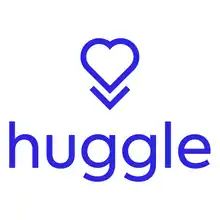Huggle (app)
Huggle is a location-based social application which connects users based on commonality of places they frequent.[1][2][3] The app was developed through a partnership with entrepreneur Andrey Andreev.[4] Following a soft launch in 2015, the app was officially launched in July 2016.[5]
 Huggle App logo | |
| Developer(s) | Huggle App Limited |
|---|---|
| Initial release | March 2015 |
| Operating system | Apple iOS (iOS 8.0 or later), Android |
| Type | Social Networking |
| Website | huggle |
History

Founders Stina Sanders and Valerie Stark met after Stark moved from Moscow to London and was using Instagram geolocation data to try and meet people that hung out where she did. They decided to create an app inspired by how they met.[6][7][8] Sanders and Stark took the idea to Andrey Andreev, the tech entrepreneur that backed Bumble, a feminist dating app, and founded dating app Badoo.[4][5] The app took six months to build and had a soft launch in 2015. The app officially launched in July 2016 and was available globally the following October.[5] The app was available for iOS, Android and Windows Phone at its release.[9] An updated version was released June 2017. By September 2017, over 45 million locations had been logged on the app.[6]
A survey of 1,500 people conducted by Huggle in 2016 showed that dating apps that match people solely on appearance have a negative impact on people's self-esteem. 62 percent of those surveyed reported that dating apps make them feel self-conscious or depressed about their appearance and over 80 percent of the women surveyed admitted to editing photographs they have uploaded.[4][10]
In February 2018, Huggle turned off its dating mode for 24 hours in an attempt to combat the pressure to find a date for Valentine's Day.[11][12]
In March 2018, it was announced that Badoo had acquired Huggle as a subsidiary.[13]
Operation
The app was originally designed as a way to make friends by connecting with people who share mutual interests, though a dating element was added in response to users looking for romantic matches.[5][6][14]
To verify a profile, users must take multiple selfies which are then approved by a team of 5,000 moderators. The actual profile is generated with information from other social media sites including Facebook, Foursquare and Instagram.[6][15][16] The user chooses whether they are looking for a date or a friend as well as ideal age range and how many places their matches must have in contact before they can contact the user.[5][6]
When two users check in to the same place, they can view each other's profiles.[6] The app automatically checks a user in at locations they visit and adds the location to their list of places. Users can then match with other people who visit that location.[2][7]
Huggle includes a "visitors" feature that allows users to see people who view their profile.[5]
Safety
The first safety feature users encounter on Huggle is a one-minute photo verification through which Huggle asks users to take selfies by copying different gestures on the screen which are first compared to uploaded pictures using 160 points on the face then verified and approved by the moderators to filter fake profiles. Users can also be verified by their phone number, Gmail account, Instagram, Twitter and LinkedIn. Huggle uses hyperlocal technology to avoid fake check-ins. To check-in at a certain location, users have to be physically present at the place. A user's list of favourite places is never shared. A person's location is only visible when both users go to the same place. Users can decide how many places they want to have in common with other users to enable them to message.[1][6]
See also
References
- Davies, Hannah J. (October 9, 2017). "Does Tinder's Menprovement initiative do enough to protect women?". the Guardian. Retrieved January 31, 2018.
- "Huggle". Wonderland Magazine. July 6, 2017. Retrieved March 19, 2018.
- Marks, Kelly (September 8, 2016). "Huggle, the new social networking app that's got our attention". Glamour. Retrieved March 19, 2018.
- Cook, James (July 2, 2016). "A new survey says dating apps like Tinder are making people self-conscious". Business Insider. Retrieved March 19, 2018.
- "Huggle: meet the women taking over the tech industry". Evening Standard. Retrieved January 31, 2018.
- "What is huggle? The dating app Katie Price has been told to join". Metro. September 11, 2017. Retrieved January 31, 2018.
- Budd, Maddy (December 20, 2016). "This is What Happened When I Tried to Make New Friends on an App". Harpers Bazaar. Retrieved March 19, 2018.
- Saul, Heather (November 23, 2016). "Young, Successful, Busy Yet Lonely: A Generation Empowered By The Internet And Plagued By Loneliness". Independent. Retrieved March 19, 2018.
- Ng, Alan (June 14, 2017). "Huggle app on iOS, Android for friends not dating". Product Reviews. Retrieved March 19, 2018.
- Weiss, Suzannah (August 17, 2016). "The Huggle App Matchers You Based On Where You Like To Go - Not On Your Appearance". Bustle. Retrieved March 19, 2018.
- Tamplin, Harley. "Tech feminist has banned Valentine's Day on her dating app".
- Barr, Sabrina. "Valentine's Day 2018: Dating App Huggle Is Encouraging Users To Celebrate Being Single on February 14".
- "Badoo Acquires Dating App Huggle And All-Female Team". Business Cloud. March 16, 2018. Retrieved March 19, 2018.
- "Huggle launch aims to help people find friends safely online". The Week. June 21, 2016. Retrieved March 19, 2018.
- Allison, Conor (September 16, 2016). "Stupid selfies can stop you being catfished". Digital Spy. Retrieved March 19, 2018.
- "Report: Online Dating: How Safe Is It Really?".